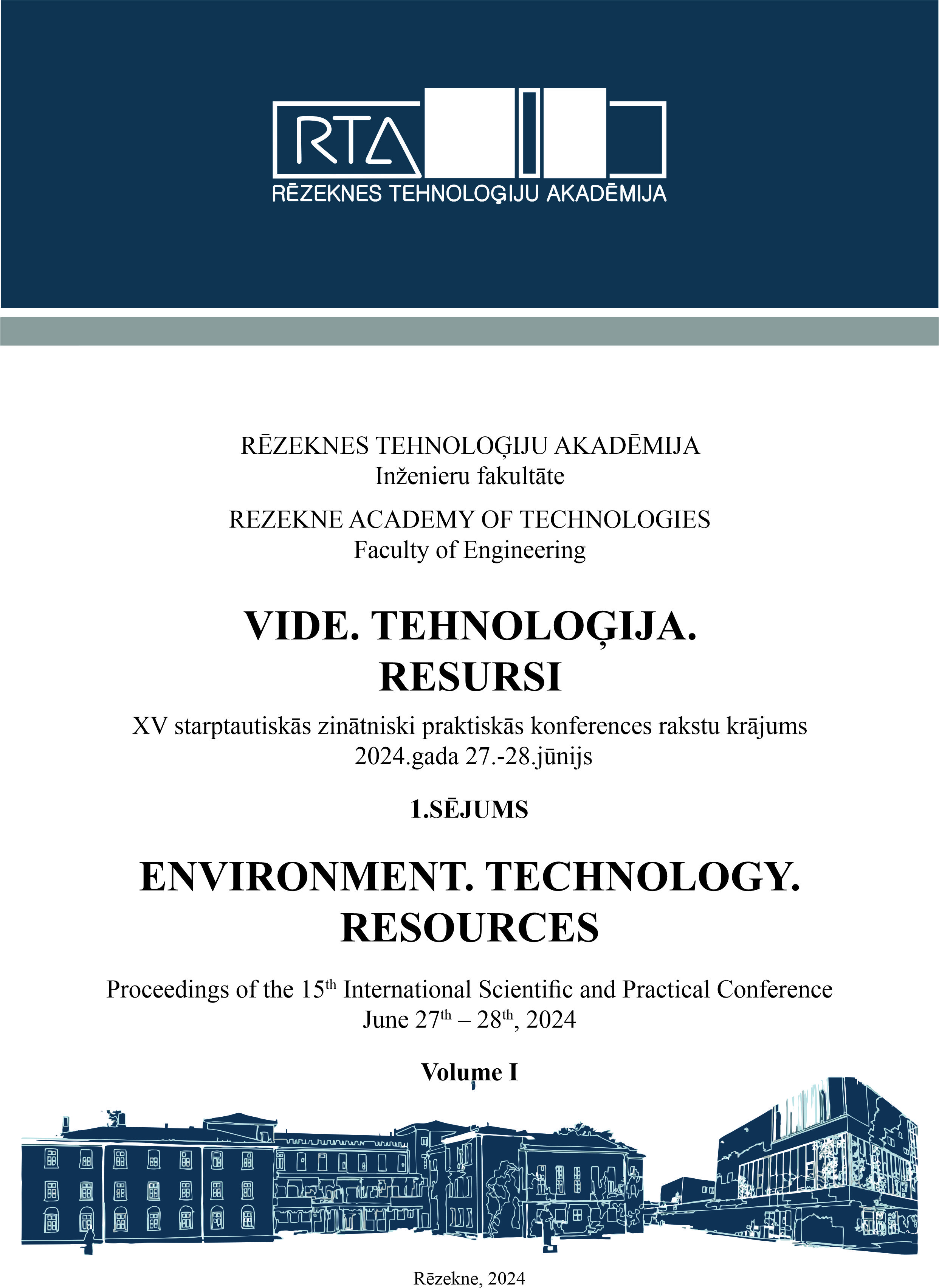OPPORTUNITIES OF IMPROVING HARVESTING TECHNOLOGIES FOR WIDER USE OF SCOTS PINE (PINUS SYLVESTRIS L.) IN CONSTRUCTION ELEMENTS
DOI:
https://doi.org/10.17770/etr2024vol1.7943Keywords:
Pinus sylvestris, resin taping, timber strength parametersAbstract
Although Pinus sylvestris has a wide distribution throughout Europe, there are lack of scientifically approved information related to the sapwood timber strength parameters impregnated with natural resins comparing to the strenth parameters of non-resinous wood and industrially impregnated roundwood assortments using as the elements of wooden constructions such as wood poles for power lines. The main goal of the study is to work out the Pinus sylvestris stems which were previously treated using resin tapping technologies and harvested in final felling sites, timber strength parameters depending on timber quality characterized data based on the testing methods: moisture content - according to ISO13061-1:2014; density - according to ISO13061-2:2014; compression strength paralel to the grain- according to ISO 13061-17:2017; modulus of elasticity- according to ISO 13061- 4:2014; three point bending strength - according to ISO 13061- 3:2014. The results of the study might help for practical applications so that this wood specie can be processed more efficiently for the value - added products whose timber quality indicators would allow it to be used in wooden structures without additional chemical and thermal treatment, to establish more accurate quality requirements for roundwood assortments and to provide useful information for optimizing Scots pine harvesting management programs.
Downloads
References
D.G.Arganbright, “Influence of extractives on bending strength of redwood (Sequoia sempervirens),” Wood Fiber Sci. 2(4), 1971, pp.367-372.
O.A.Badran, and M.L.M. El-Osta, “Influence of specific gravity and extractive content on maximum crushing strength of wood,” Alexandria J. Agric. Res. 25(3), 1977, pp.541-548.
L.G. Esteban, P. Gasson, J.M.Climent, P. de Palacios, P., and A. Guindeo, “The wood of Pinus canariensis and its resinous heartwood,” IAWA J. 26(1), 2005, pp. 69-77. DOI: 10.1163/22941932-90001602
V.R. Franceschi, P. Krokene, E. Christiansen, E., and T. Krekling, “Anatomical and chemical defenses of conifer bark against bark beetles and other pests,” New Phytol. 167(2), 2005, pp. 353-375. DOI: 10.1111/j.1469-8137.2005.01436.x
A. García-Iruela, J.G. Esteban, P. de Palacios, F. García-Fernández, A. de Miguel Torres, E. Vázquez Iriarte and C. Simón, "Resinous wood of Pinus pinaster Ait.: Physico-mechanical properties," BioRes. 11(2), 2016, pp. 5230-5241.
M. Genova, L. Caminero, J. Dochao, Resin tapping in Pinus pinaster: effects on growth and response function to climate. Eur J For Res 133:, 2014, pp. 323–333
A. Gutierrez, and F. Plaza, Características Físico-Mecánicas de las Maderas, 1976.
Españolas, Instituto Forestal de Investigaciones y Experiencias, Madrid, Spain.
J.G. Haygreen, and J.L.Bowyer, Forest Products and Wood Science: An Introduction, Iowa State University Press, IA, USA, 1996.
R.Hernández, “Influence of accessory substances, wood density and interlocked grain on the compressive properties of hardwoods, ”Wood Science and Technology. 41, 2007, pp.249-265. DOI: 10.1007/s00226-006-0114-5
ISO 3129:2012 Wood – Sampling methods and general requirements for physical and mechanical testing of small clear wood specimens
ISO-13061-1:2014 Moisture content for bending specimens
ISO-13061-2-2014, Density for bending specimens
ISO-3129-1975 (E). Wood -Sampling methods and general requirements for physical and mechanical tests. First edition -1975-11-01
ISO/TC/218/WG1/N017 ISO/DIS 24294, Timber-Round and Sawn Timber-Vocabulary
ISO 13061-3(4)-2014, Three point bending strenght and modulus of elasticity
ISO 13061-3(4)-2014, Three point bending strenght and modulus of elasticity
Kalniņš, A. (1944) Ķīmiskā meža technoloģija [Wood chemistry technology]. Saimniecības literatūras apgāds. Riga , 350 p. [in Latvian]
K.W.Kim, I.J. Lee, C.S. Kim, I.Y. Eom, J.W. Choi, D.K. Lee, and E.W. Park, “Resin flow, symptom development, and lignin biosynthesis of two pine species in response to wounding and inoculation with Fusarium circinatum,” Plant. Pathol. J. 26(4), 2010, pp. 394-401. DOI: 10.5423/PPJ.2010.26.4.394
L.Knebel, D.J. Robison, T.R. Wentworth, and K.D. Klepzig, “Resin flow responses to fertilization, wounding and fungal inoculation in loblolly pine (Pinus taeda) in North Carolina,” Tree Physiol. 28(6), 2008, pp.847-853.
F. F. P.Kollmann, and W. A. Côté, Principles of Wood Science and Technology, Springer Verlag, New York, NY, USA, 1968.
LVS EN 338:2016 Structural timber - Strength classes
Z. Miklašēvičs, M. Neicinieks, Augošu koku un kokmateriālu kvalitāte [The quality of growing tree and roundwood]. AS „Latvijas valsts meži”:, 2014, 128 p. [in Latvian].
Z. Miklašēvičs, The technical investigations and ecological appreciation of manufacturing of wood pole’s for power lines. Doctoral Thesis Latvia University of Agriculture. Forest Faculty. Jelgava 2004. Doctoral thesis for the doctoral degree Doctor of Science (Ph.D.) in wood materials and technology https://llufb.llu.lv.engineering.Z_Miklasevics_1-a
K. Pernestål, B. Jonsson, and B. Larsson, “A simple model for density of annual rings,” Wood Sci. Technol. 29(6), 1995, pp. 441-449. DOI: 10.1007/BF00194202
M. A.Phillips, and R. B. Croteau, “Resin-based defense in conifers,” Trends Plant Sci. 4(5), 1999, pp.184-190. DOI: 10.1016/S1360-1385(99)01401-6
P. Rasiņš and A. Vilipsons A. Atsveķošana [Resin tapping]. Latvijas Valsts izdevniecība. Riga, 1960, 250 p. [in Latvian]
Rodríguez-García, A., López, R., Martín, J. A., Pinillos, F., and Gil, L. (2014). “Resin yield in Pinus pinaster is related to tree dendrometry, stand density and tapping-induced systemic changes in xylem anatomy,” Forest Ecol. Manag. 313, 47-54. DOI: 10.1016/j.foreco.2013.10.038
J.J.Ruel, M.P. Ayres, and P.L. Lorio, “Loblolly pine responds to mechanical wounding with increased resin flow,” Can. J. Bot. 28(4), 1998, pp. 596-602. DOI: 10.1139/cjfr-28-4-596.
E.M.Silva, C. Loureiro, J. Pires, Influence of resin tapping on wood characteristics and properties. Incredible, Innovation Network for Cork, Resin & Edibles. FACTSHEET 20255, 2020.
A.Zaluma, Z. Strike, R. Rieksts-Riekstiņš, et al. Long-term pathological consequences of resin tapping wounds on stems of Scots pine (Pinus sylvestris L.). Trees 36, 2022, pp. 1507–1514. https://doi.org/10.1007/s00468-022-02307-y
Downloads
Published
Issue
Section
License
Copyright (c) 2024 Ziedonis Miklašēvičs

This work is licensed under a Creative Commons Attribution 4.0 International License.



